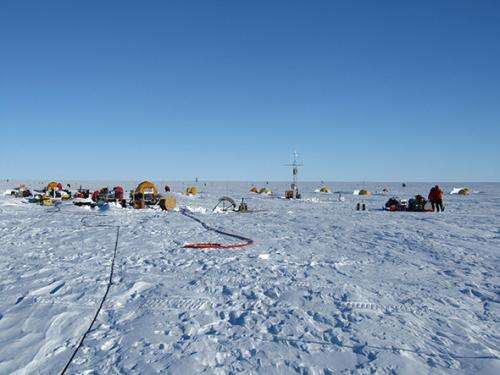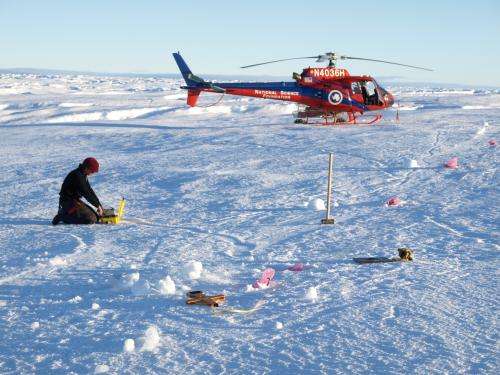Antarctic research details ice melt below massive glacier

An expedition of international scientists to the far reaches of Antarctica's remote Pine Island Glacier has yielded exact measurements of an undersea process glaciologists have long called the "biggest source of uncertainty in global sea level projections."
The research, which appears in the latest issue of Science magazine, was conducted by scientists at New York University's Courant Institute of Mathematical Sciences, the Naval Postgraduate School (NPS) in Monterey, Calif., the University of Alaska, Pennsylvania State University, NASA, and the British Antarctic Survey.
The article details the landmark results of the Pine Island Glacier expedition, giving scientists an extensive look beneath the ice at one of the most remote research sites on the planet – a site whose fate could affect the lives of millions.
"Intensive melting under the Pine Island ice shelf, as observed in our study, could potentially lead to the speed up and ultimate break-up of the ice shelf," says David Holland of NYU's Courant Institute and one of the paper's co-authors. "That's important, as this ice shelf is currently holding back inland ice, and without that restraining force, the Pine Island catchment basin could further contribute to global sea-level rise."
Given the flow of warm sea water below the glacier, scientists have long known that Pine Island Glacier was melting from below – the accelerated flow of Western Antarctic Ice Shelf glacial ice into the Amundsen Sea has been a concern of scientists since the late '80s. An exhaustive expedition to the 50km-long floating ice shelf at the outer reaches of the glacier field, and 500 meters down into it, reveal the first measurements detailing ice-shelf melting rates and processes within melt channels bore into the shelf underbelly.

"Fresh water forms every time [the sea] injects heat into the shelf," said NPS Research Professor Tim Stanton. "The warm water starts to melt the ice at the grounding line and creates a buoyant plume called a boundary layer current. We measured the effects of that current for the first time."
"What we have brought to the table are detailed measurements of melt rates that will allow simple physical models of the melting processes to be plugged into computer models of the coupled ocean/glacier system," he added. "These improved models are critical to our ability to predict future changes in the ice shelf, and glacier-melt rates of the potentially unstable Western Antarctic Ice Sheet in response to changing ocean forces."
The measured glacial melt rate at the site, and through the channel on Pine Island, at approximately six centimeters per day, reveals a critical need to understand channelized melting underneath massive glaciers, as they are major contributors to global sea-level rise now and into the future.
More information: "Channelized Ice Melting in the Ocean Boundary Layer Beneath Pine Island Glacier, Antarctica," by T.P. Stanton et al Science, 2013. www.sciencemag.org/content/341 … e6-b849-47d2211d90e8
Journal information: Science
Provided by New York University



















